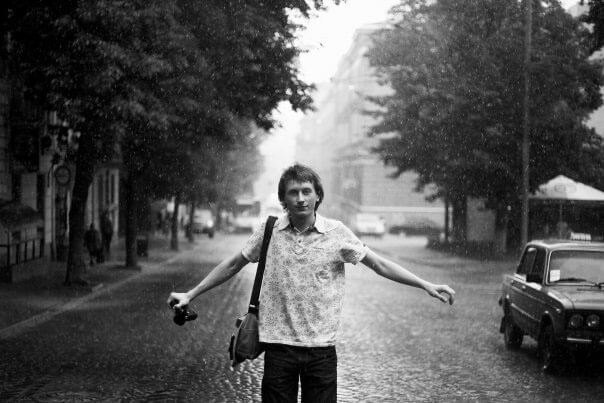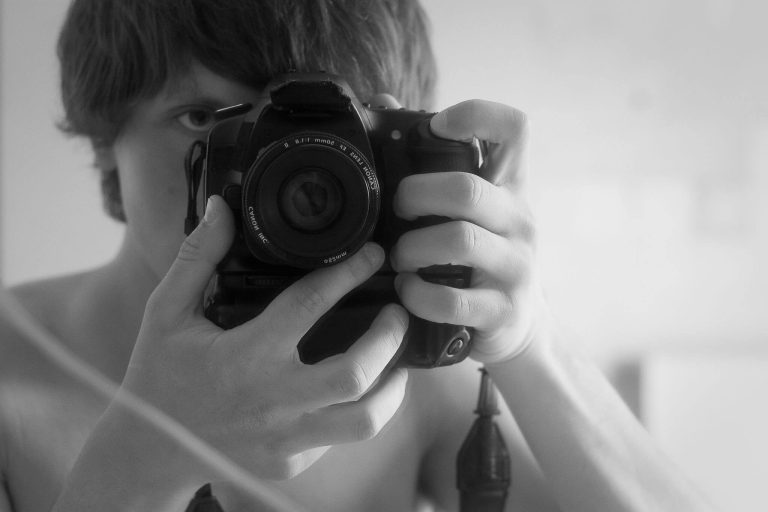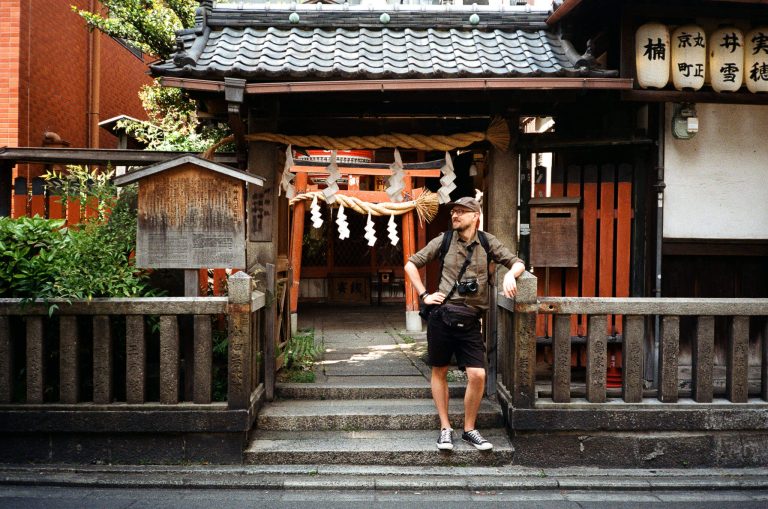Intro: Film Photography Tips for Beginners (And Why It’s Easier Than You Think to Get Started)
If you’ve been curious about film photography for beginners, you’re in the right place.
The truth is that film photography doesn’t have to be complicated. And in a world of limitless memory cards and infinite megapixels, film offers something rare: real intention. Real beauty. Real magic.
My love for film photography started when I was just 5 years old. At least once per week my father would load up a slide projector and show me vivid images of landscapes, people and places from around the world. Holding one of those tiny slides up to the light felt like looking through a window into another universe. But when the projector lit up the room — that’s when the magic truly happened. I didn’t understand how it worked, only that this was impressive.

Years later, in my early 20s, I stumbled across a Zenit SLR at a flea market. I had only used point-and-shoot film cameras up to that point — the type that just focused and fired. But the Zenit was manual. It asked me to slow down, think, learn. I had no clue how to set shutter speed or aperture (but I had some experience with digital cameras). With a few of my father’s books, I started to grasp film photography basics — especially exposure.
My Film Journey: From Mistakes to Rediscovery and Growth
The first roll turned out okay. But my second one was a disaster. I dropped the camera, it opened and ruined the whole roll. Lesson learned: use a neck strap. After that unlucky experience, like many other beginner photographers (that was a huge mistake), I drifted toward digital. I bought a Canon DSLR in 2009, tempted by instant results and convenience.

But in early 2025, something changed. I picked up a Pentax K2, bought a Minolta AF-D for my girlfriend, and fell in love with film all over again. And this time, I’m not putting it down.
There’s a reason film is making a comeback. In fact:
“35mm film camera sales jumped 30% between 2022 and 2024, driven by younger photographers returning to analog.”
— Ilford Photo Market Report, 2024
So if you’re thinking about exploring 35mm film photography or medium format, now’s the perfect time.
In this post, I’ll share the 5 biggest reasons why you should try it. These aren’t vague “film is better” takes — they’re personal, practical, and tested by me. So you can have a smoother experience.
Let’s dive in.
Reason 1: Film Photography Slows You Down — and That’s a Good Thing
Film Photography Forces You to Slow Down — and That’s a Feature, Not a Bug.
Over the past decade I owned 5 different DSLRs and mirrorless cameras from Canon and Fuji. I always was more than satisfied with the results and overall image quality. But something was missing. The photographs from most modern cameras always felt “too perfect” and artificial to me.
To improve that I often added some grain in Lightroom, experimented with LUTs and film emulations. Long story short — I was after recreating a “film look”.
Than one day I asked myself — “If I’m eager to emulate film so much, why not to try it?”. That was the first seed that grew into a new passion.
When I picked up my Pentax K2 earlier this year in Chiang Mai I had to re-think the process: now I have only 36 exposures, and each of them shares the total cost of a film roll. This new process of photographing required a different approach.
In a world of burst mode, and 10,000-photo vacations, film makes you calm down and think. That’s exactly why beginners should try it.
Here’s why slowing down actually makes you a better photographer:
1. You have a shot limit.
With 36 exposures (or 24), every frame counts. No “spray and pray.” You actually have to decide what’s worth shooting. Shocking, right?
2. There’s no instant gratification.
You can’t chimp the back of the camera. The wait for development teaches patience — and forces you to visualize before you click.
3. Mistakes hurt (in a good way).
Mess up your exposure? That’s $5-$15 you’ll never see again. Pain = learning. Film slaps your hand in ways digital never will. And that’s a good thing. You wouldn’t believe me if I’ll say how fast you skill starts to grow because of this.
4. You slow down your composition.
You’ll spend 30 seconds just looking through the viewfinder. Framing. Adjusting. Thinking. It’s basically meditation with a shutter button. Why hurry, I love photography and enjoy it, it’s not a speed track.
5. Manual settings actually matter.
You can’t rely on auto-anything. Learning ISO, aperture, and shutter speed becomes non-negotiable. That’s why film photographers tend to understand light so well.
Slow is smooth. Smooth is sharp.
Film teaches you to get there.
Reason 2: You Learn More About Light and Exposure
Film Photography Teaches You More About Light Than Any YouTube Tutorial Ever Will.
If you want to really understand exposure, shoot a roll of film. You’ll stop relying on luck and start learning the logic behind every frame.
Here’s how film makes you smarter with light:
1. There’s no histogram or preview.
You either expose it right, or you waste a shot. With no LCD to check, you’re forced to think before you shoot — and that’s where growth happens.
2. You start using light meters (yes, really).
You’ll either use a handheld meter or learn the Sunny 16 rule. Either way, you’ll start reading light instead of guessing.
3. You realize ISO is baked into the film.
Film speed isn’t adjustable. If you shoot 400 ISO film, that’s what you’ve got. You learn to work within limits — and limits build creativity. Trust me, this is a good thing.
4. You start to see light differently.
You’ll notice harsh shadows, golden hour softness, backlight flare — things you ignored with digital. Film rewires your vision.
5. You can’t “fix it in post.”
Blown highlights are gone forever. Crushed shadows will not recover. You learn to nail exposure in-camera — a skill that transfers perfectly to digital and video. So you fix it before the shutter — which leads to better habits and cleaner results over time. This is huge, each mistake is hard coded into your brain, so you won’t do it again.
Want to master exposure?
Load a roll of 35mm and go practice. Enjoy the process. No need to hurry.
Reason 3: The Look of Film Can’t Be Replicated Perfectly
No matter how many presets you buy, you still can’t fake the look of real film.
I spent hours editing digital photos to “look like film.” I tried Lightroom presets, Davinci Resolve Powergrades, Plugins, LUTs, you name it. You could spend that same time just shooting film — and get the real thing INSTANTLY!
Remember the A-HA moment I shared at the beginning that struck me like a bolt of lightning — why try to emulate something that can be achieved in real life? No matter how hard I tried, my film emulations were always a few steps behind.
Here’s why film’s look is still unmatched:
1. Film has natural imperfections that look human.
Grain, halation, light leaks, color science, development timings, chemicals, film scanners settings — film embraces flaws. These flaws are random, not rendered. That’s why film feels emotional instead of clinical. No to people are identical, this is what makes us so unique. So is film.
2. Film handles highlights better than digital.
Digital clips bright areas fast. Film, especially color negative, rolls off highlights gently. Skin tones stay soft. Skies don’t burn out. You get nuance, not nukes. It’s timeless. That’s why masters like Christopher Nolan, Quentin Tarantino and many others prefer film instead of much “more advanced” digital cameras.
3. Film has built-in color science.
Kodak Portra 400, Fujifilm Superia, Ilford FP4 (my favorite black and white film) — each film stock bakes in a look. No LUTs, no sliders. Just a built-in vibe factory. Try them all, and you’ll be amazed every single time.
4. Film reacts to light differently.
Shadow rolloff, contrast curves, latitude — these are physics, not filters. You can’t Lightroom your way into these results. (Trust me. I’ve tried. A lot.)
5. Presets often look like someone tried too hard.
The “film look” preset guy is out here with teal shadows, orange midtones, and grain set to “popcorn ceiling.” Real film doesn’t try that hard — and still looks cooler.
6. Film doesn’t age — it evolves.
As stocks get older or rarer, they change. Your Portra in 2025 won’t look like someone else’s in 2003. That uniqueness is impossible to copy.
Shoot real film. Save yourself the hours in Lightroom — and stop pretending grain equals soul.
Reason 4: The Gear is Affordable (If You Start Smart)
Film Photography Doesn’t Have to Be Expensive — Unless You Let Instagram Talk You Into It (Please Don’t).
You can get started with great film gear on a budget, but only if you avoid hype traps and make smart choices. To be honest — just start with any gear today, and you can always “upgrade” later if needed. When I purchased my Pentax, I had no idea of what to expect — but it turned out a million times better than I imagined. Point & shoot Minolta AF-D? Same feelings: tiny camera, no settings, tremendous results. I just keep buying different film stocks to find my favorite one.
Here’s how to do it right:
1. Start with a reliable, fully manual 35mm camera.
Cameras like the Pentax K1000, Canon AE-1, or Minolta SRT are durable, beginner-friendly, and affordable. They actually teach you how photography works. I bought my Pentax K2 with a 50mm f/1.7 lens for under $100. It’s the same analog technology used by Stanley Kubrick on all of his films — cool, right?
2. Avoid the hype-beast gear.
Buying a Contax T2 because some youtuber used one? That’s $1,000 for a point-and-shoot. And that’s not a camera, it’s a financial cry for help.
3. Buy from local sellers or camera shows.
You’ll often pay less than online listings — and you get to test the camera before buying. Avoid those “mint condition” eBay scams unless you enjoy disappointment. I prefer buying in person. It’s more reliable, and honestly, spending a day out walking and meeting people is part of the adventure.
4. Stick to common film stocks at first.
Kodak Gold, Ultramax 400, or Fujifilm Superia are all solid and affordable. Avoid expired film unless you want surprise soup-colored negatives.
5. Learn to scan your own negatives.
Flatbed scanners or DSLR scanning setups can save you $$$ over lab scans. It’s an upfront investment that pays off fast. I will write about that soon, stay tuned for my scanning advice blog post.
6. Don’t buy everything at once.
You don’t need 5 lenses, a light meter, and a camera bag that costs more than your rent. Start small. Shoot more. Enjoy the process of photographing, not hoarding.
Film gear is still accessible — if you buy it wisely.
Reason 5: Join a Passionate, Supportive Community
Film Photography Isn’t Just a Hobby — It’s a Lifestyle.
If you shoot film, you’re not doing it alone. You’re joining one of the most passionate and weirdly enthusiastic communities on the internet (and in real life). Join film photography — it’s cheaper than therapy (until it isn’t).
Here’s what makes it so special:
1. People actually want to help you.
Ask a beginner question on r/analog or a Facebook group, and you’ll get five thoughtful answers in 10 minutes — plus one guy telling you to shoot medium format immediately. If you’re a beautiful girl, some may even come to your city and teach you in person for free.
2. Photo walks are a thing.
Cities around the world host analog meetups. You show up, talk gear, shoot a roll, and maybe grab a beer. Instant friendship. That small talk often turns into deep conversations, shared experiences, and real friendships. All sparked by a love of film.
3. You’ll discover zines, swaps, and film labs run by actual humans.
Unlike mass digital workflows, the analog space is full of indie creators. People mail each other film. Trade prints. Make zines. It’s basically the punk rock of photography.
4. You don’t need to be “good” to be accepted.
Film folks love the process. Share a blurry shot with weird light leaks? You’ll still get praise for trying something new. Try posting that in a Sony shooters forum. You’ll be exiled. That’s why I prefer Canon & Fuji. Just kidding, Sony creates great products as well.
5. You’ll actually stick with photography longer.
Stats show people involved in niche creative communities are more consistent — and happier. (Also, it’s just more fun with people.) That’s why I wrote this blog post — film photography is pure magic to me, and I want this magic to be shared.
Shoot film, make friends.
If you’re ready to try film photography as a beginner, here’s your next step: don’t overthink it.
Grab a film camera, load a roll, call a friend, and go shoot this week.
Ask strangers if you can take their portrait—you’ll be surprised how open and friendly people can be. Just give it a shot.
Still have doubts or questions? Leave a comment below or send me an email. I read every email and usually reply within 24 hours.

-Ustin
